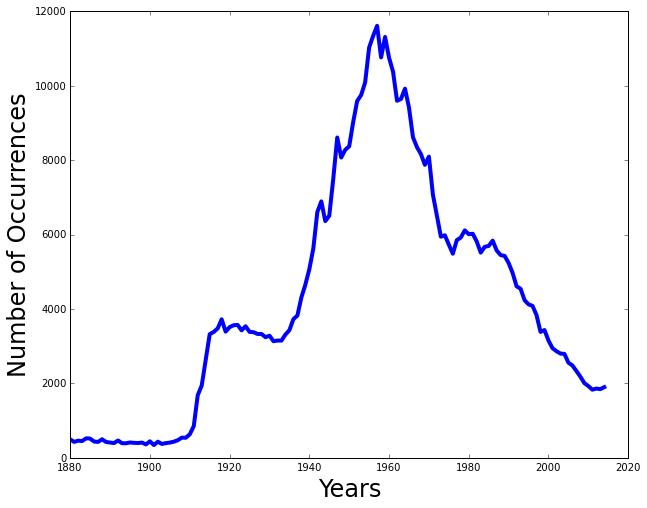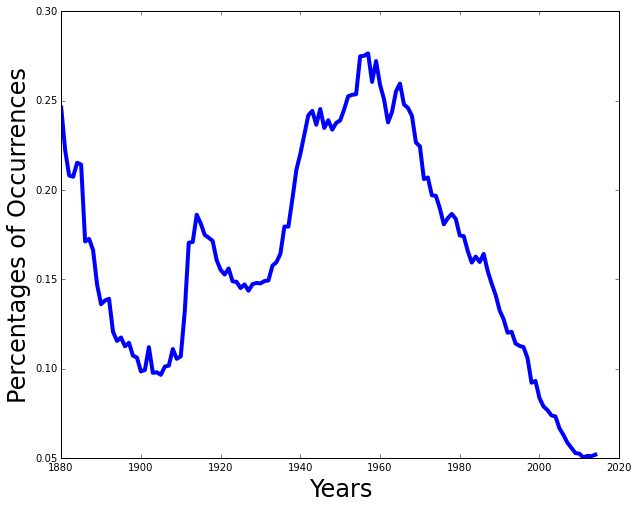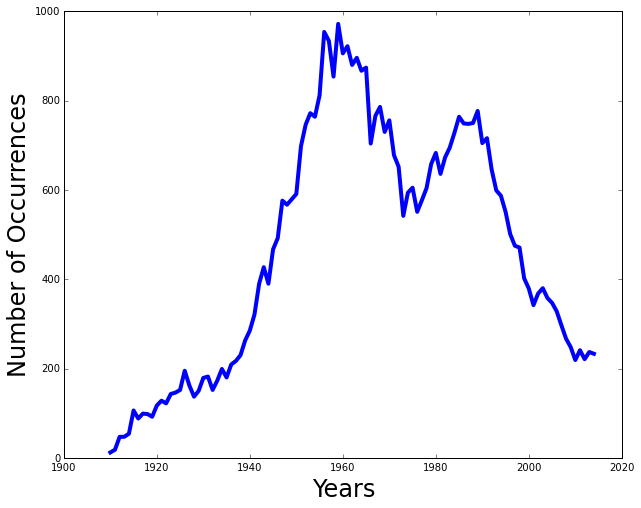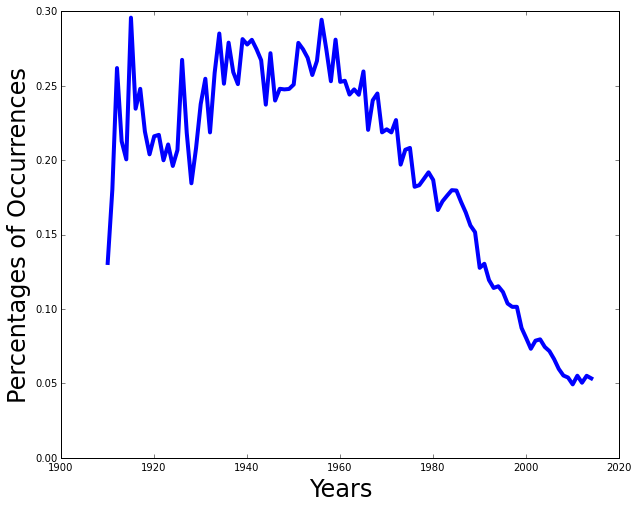Notebook 07: File I/O
Overview
The goal of this assignment is to allow you to practice reading data from files, performing some analysis on the data, and then presenting the data visually via plots and graphs in the Python programming language. Additionally, you will continue to practice decomposing large problems into smaller sub-problems in each of these activities.
To record your solutions and answers, create a new Jupyter Notebook
titled Notebook07.ipynb and use this notebook to complete the following
activities and answer the corresponding questions.
Make sure you label your activities appropriately. That is for Activity 1, have a header cell that is titled Activity 1. Likewise, use the Markdown cells to answer the questions (include the questions above the answer).
This Notebook assignment is due Midnight Friday, November 6, 2015 and is to be done individually.
Activity 0: Baby Names Dataset
For all the activities for this Notebook, you will be working on data from
the Social Security Administration. In particular, you will be examining
the most popular (top 1000) baby names from 1880 to 2014. Before
you can analyze and visualize this data, however, you must first download
the data from the Social Security Administration website, and then
extract the information on your local computer.
To do this, you are to write the following functions:
-
ls(path=os.curdir, sort=True):Given a
pathto a directory, this function prints the names of all the files in that directory. IfsortisTrue, then the contents are printed in lexigraphical order. -
head(path, n=10):Given a
pathto a file, this function prints the firstnlines in the file. -
tail(path, n=10):Given a
pathto a file, this function prints the lastnlines in the file. -
download_and_extract_zipfile(url, destdir):Given a
url(i.e. a uniform resource locator) to a zipfile, this function retrieves the file via a HTTP request and then extracts all the contents of the file to the specifieddestdir.
Code Skeleton
The following is a skeleton of the code you must implement to complete this activity.
# Imports
import os
import requests
import zipfile
import StringIO
# Constants
NATIONAL_DATA_URL = 'https://www.ssa.gov/oact/babynames/names.zip'
NATIONAL_DATA_DIR = 'national_baby_names'
STATE_DATA_URL = 'https://www.ssa.gov/oact/babynames/state/namesbystate.zip'
STATE_DATA_DIR = 'state_baby_names'
# Functions
def ls(path=os.curdir, sort=True):
''' Lists the contents of directory specified by path '''
# TODO: Implement function
def head(path, n=10):
''' Lists the first n lines of file specified by path '''
# TODO: Implement function
def tail(path, n=10):
''' Lists the last n lines of file specified by path '''
# TODO: Implement function
def download_and_extract_zipfile(url, destdir):
''' Downloads zip file from url and extracts the contents to destdir '''
# TODO: Request URL and open response content as ZipFile
# TODO: Extract all zip data to destdir
Once you have implemented the download_and_extract_zipfile function, use
it retrieve and extract both the national dataset and the state dataset
to your local computer:
>>> download_and_extract_zipfile(STATE_DATA_URL, STATE_DATA_DIR)
Once you have implemented the ls, head, and tail functions, use them
to explore the extracted datasets:
>>> ls(STATE_DATA_DIR)
AK.TXT
... SNIP ...
WY.TXT
>>> head('state_baby_names/IN.TXT')
IN,F,1910,Mary,619
IN,F,1910,Helen,324
IN,F,1910,Ruth,238
IN,F,1910,Dorothy,215
IN,F,1910,Mildred,200
IN,F,1910,Margaret,196
IN,F,1910,Thelma,137
IN,F,1910,Edna,113
IN,F,1910,Martha,112
IN,F,1910,Hazel,108
>>> tail('state_baby_names/IN.TXT')
IN,M,2014,Tryston,5
IN,M,2014,Tyreese,5
IN,M,2014,Tyrone,5
IN,M,2014,Vernon,5
IN,M,2014,Viktor,5
IN,M,2014,Waylen,5
IN,M,2014,Xavi,5
IN,M,2014,Yael,5
IN,M,2014,Zain,5
IN,M,2014,Zakary,5
Hints
The following are hints and suggestions that will help you complete this activity:
-
To get the contents of a directory or folder, you can use the os.listdir function.
-
When iterating over a file handle, each line contains the trailing newline, so use the str.strip method to remove any unnecessary whitespace.
-
To retrieve a file over HTTP, use the requests.get method on a URL. The contents of the response object can be accessed via: response.content.
-
To convert a string into a file object, use the StringIO.StringIO function.
-
To open a file object as a zipfile, use the zipfile.ZipFile function. To extract all the contents of the file, use the ZipFile.extractall method.
Questions
After completing the activity above, answer the following questions:
-
Retrieve the national dataset and extract it to
NATIONAL_DATA_DIR. Explore the contents of theNATIONAL_DATA_DIRfolder. How is the national dataset organized? What is the format of each individual file? -
Retrieve the state dataset and extract it to
STATE_DATA_DIR. Explore the contents of theSTATE_DATA_DIRfolder. How is the state dataset organized? What is the format of each individual file?
Activity 1: National Baby Names
For this activity, you are to process all of the files in the national
dataset and generate two plots of your name from 1880 to 2014:
-
The first graph you should produce is a plot of the raw number of occurrences for each year.
-
The second graph you should produce is a plot of the percentage of occurrences for each year (how many times your name appeared relative to the total number of names).
Imports
To have the plots display inline inside the Jupyter Notebook, you must first execute the following command:
%matplotlib inline
Once this is done, any plots you generate will show us as an image inside the Notebook.
To access the plotting functions, you must perform the following import:
import matplotlib.pyplot as plt
Functions
To complete this activity, we can break the activity down into the following functions:
-
Count the occurrences in a year file
def count_occurrences_in_year(path, baby_name): ''' Return the number of occurrences for the baby_name and the total number of babies for the year file specified by path '''Given the
pathto a year file and a targetbaby_name, return the number of occurrences for thebaby_nameand the total number of names for that year.Once you have completed this function, you should be able to do the following:
>>> count_occurrences_in_year(os.path.join(NATIONAL_DATA_DIR, 'yob1880.txt'), 'Peter') (496, 201484)This means that the name
Peterwas given to496out of201484babies in the year1880. -
Count the occurrences in a range of years
def count_occurrences_in_years(path, baby_name, years): ''' Return a list of occurrences for the range of years in the data directory specified by path '''Given the
pathto a directory containing the years data, list ofyears, and a targetbaby_name, return a list of all the occurrences ofbaby_nameand the total number of names for each year. Internally, this function uses thecount_occurrences_in_yearfunction.Once you have completed this function, you should be able to do the following:
>>> count_occurrences_in_years(NATIONAL_DATA_DIR, range(1880, 2015), 'Peter') [(496, 201484), (428, 192700), (461, 221537), ... SNIP ... (1859, 3638838), (1833, 3608097), (1899, 3670151)]This returns a list of pairs containing the number of occurrences of the name
Peteralong with the total number of names for each year from1880through2014. -
Plot the national occurrences
def plot_national_occurrences(data, years): ''' Plot the number of occurrences in the given range of years '''Given the
datareturned fromcount_occurrences_in_yearsand a range ofyears, plot the number of occurrences for each year.Once you have completed this function, you should be able to do the following:
>>> years = range(1880, 2015) >>> data = count_occurrences_in_years(NATIONAL_DATA_DIR, years, 'Peter') >>> plot_national_occurrences(data, years)
This shows the number of occurrences for the name
Peterfor the years1880to2014. -
Plot the national percentages
def plot_national_percentages(data, years): ''' Plot the percentages of occurrences in the given range of years '''Given the
datareturned fromcount_occurrences_in_yearsand a range ofyears, plot the percentage of occurrences for each year (i.e. number for that year / total for that year).Once you have completed this function, you should be able to do the following:
>>> years = range(1880, 2015) >>> data = count_occurrences_in_years(NATIONAL_DATA_DIR, years, 'Peter') >>> plot_national_percentages(data, years)
This shows the percentage of occurrences for the name
Peterfor the years1880to2014.
Hints
The following are hints and suggestions that will help you complete this activity:
-
Use the str.split method to separate the comma-separated-values from the year files.
-
Remember that data read from a file is stored in a string. If you want a field to be another type (i.e. an
int), then you must explicitly cast to that type. -
Remember that the path to a file is simply a string, so you can use all your normal string methods such as str.format to build the path to a year file.
-
To compute the percentage, you can use the following formula:
percentage = count * 100.0 / total -
Once you have your data organized, you can plot the graphs using the following code:
plt.figure(figsize=(10, 8)) plt.plot(years, occurrences, linewidth=4) plt.xlabel('Years', fontsize=24) plt.ylabel('Number of Occurrences', fontsize=24)Play around with the parameters to figure, plot, xlabel, ylabel to stylize the plot to your liking.
Don't Print Large Files
If you try to print a large file you will most likely lock up your Notebook.
Questions
After completing the activity above, answer the following questions:
-
Described how you processed the data. What did you need to keep track of during your processing of the data? How was this information used to produce your plots? What difficulties did you encountered in processing the data and how did you overcome them?
-
Do the results of the plots surprise you? Where are there spikes in your graphs and what historical events would explain those spikes?
Activity 2: State Baby Names
For this activity, you are to do basically the same thing as in the previous activity, except on the state dataset (the national dataset was for all names in the nation, while this dataset is broken down by state).
Functions
To complete this activity, we can break the activity down into the following functions:
-
Count the yearly occurrences in a state file
def count_yearly_occurrences_in_state(path, baby_name): ''' Return a dict with the number of occurrences for the baby_name in each year '''Given the
pathto a state file and a targetbaby_name, return a dict with the number of occurrences of the targetbaby_namein each year.Once you have completed this function, you should be able to do the following:
>>> count_yearly_occurrences_in_state('state_baby_names/CA.TXT', 'Peter') {1910: 12, 1911: 18, 1912: 47, 1913: 47, ... SNIP ... 2011: 241, 2012: 221, 2013: 237, 2014: 233}This means that the name
Peterwas given to12babies in1910in the state of California,18babies in1911, etc. -
Count the total yearly occurrences in a state file
def count_yearly_totals_in_state(path): ''' Return a dict with the total number of occurrences in each year. '''Given the
pathto a state file, return a dict with the total number of occurrences in each year.Once you have completed this function, you should be able to do the following:
>>> count_yearly_totals_in_state('state_baby_names/CA.TXT') {1910: 9164, 1911: 9984, 1912: 17944, 1913: 22094, ... SNIP ... 2011: 436857, 2012: 438069, 2013: 430088, 2014: 436552}This means that there were a total of
9164babies born in1910,9984in1911, etc. -
Plot the state occurrences
def plot_state_occurrences(data): ''' Plot the number of occurrences for the state data '''Given
datareturned fromcount_yearly_occurrences_in_state, plot the number of occurrences for each year.Once you have completed this function, you should be able to do the following:
>>> data = count_yearly_occurrences_in_state('state_baby_names/CA.TXT', 'Peter') >>> plot_state_occurrences(data)
This shows the number of occurrences for the name
Peterfor the years1910to2014in California. -
Plot the state percentages
def plot_state_percentages(data, totals): ''' Plot the percentages of occurrences for the state data '''Given
datareturned fromcount_yearly_occurrences_in_stateand thetotalsfromcount_yearly_totals_in_state, plot the percentage of occurrences for each year (i.e. number for that year / total for that year).Once you have completed this function, you should be able to do the following:
>>> data = count_yearly_occurrences_in_state('state_baby_names/CA.TXT', 'Peter') >>> totals = count_yearly_totals_in_state('state_baby_names/CA.TXT') >>> plot_state_percentages(data, totals)
This shows the percentage of occurrences for the name
Peterfor the years1910to2014in California.
Hints
The following are hints and suggestions that will help you complete this activity:
-
Remember that a dict has a dict.get method where you can set a default value should a key not exist in the dict.
-
Remember that a dict provides access to a list of the key, value pairs via the dict.items method.
-
Remember that you can sort the items in dict using sorted.
-
You can implement
count_yearly_totals_in_statein terms ofcount_yearly_occurrences_in_stateif you interprete aNonevalue for thebaby_nameparameter as matching any name. -
To plot, you will need to separate the keys and values from the input
datadict.
Questions
After completing the activity above, answer the following questions:
-
Described how you processed the data. Compare how you processed the data in this exercise with how you did it in the previous exercise. What was different? What was the same?
-
Do the trends for your birth state match the national trends? What reasons do you think would lead to these discrepancies if there are any?
Activity 3: Open Exploration
For the third activity, you are to produce two additional graphs or plots from the baby names dataset. Here is a list of some possible ideas, but you are more than welcome to come up with your own:
-
Plot the number of occurrences of two names on the same plot.
-
Plot the ratio of male to female names over time.
-
Create a histogram for a particular year or for particular name based on number of occurrences.
-
Plot the number of unisex names (that is names are used for both genders).
-
Compare the popularity of a name from multiple states on the same plot.
-
Compare your first and middle name on the same plot.
-
For each plot, write a summary that analyzes the data and what it means.
Hints
The following are hints and suggestions that will help you complete this activity:
-
As we have done in the previous activities, write smaller utility functions where each function has clear and focused purpose.
-
Re-use these smaller functions by combining them in another function to solve the overall problem.
Questions
For each plot or graph you produced, write a summary that describes how you collected the data for the figure, analyzes the results, and discusses the significance of the findings.
Submission
To submit your notebook, follow the same directions for Notebook00, except store this notebook in the notebook07 folder.